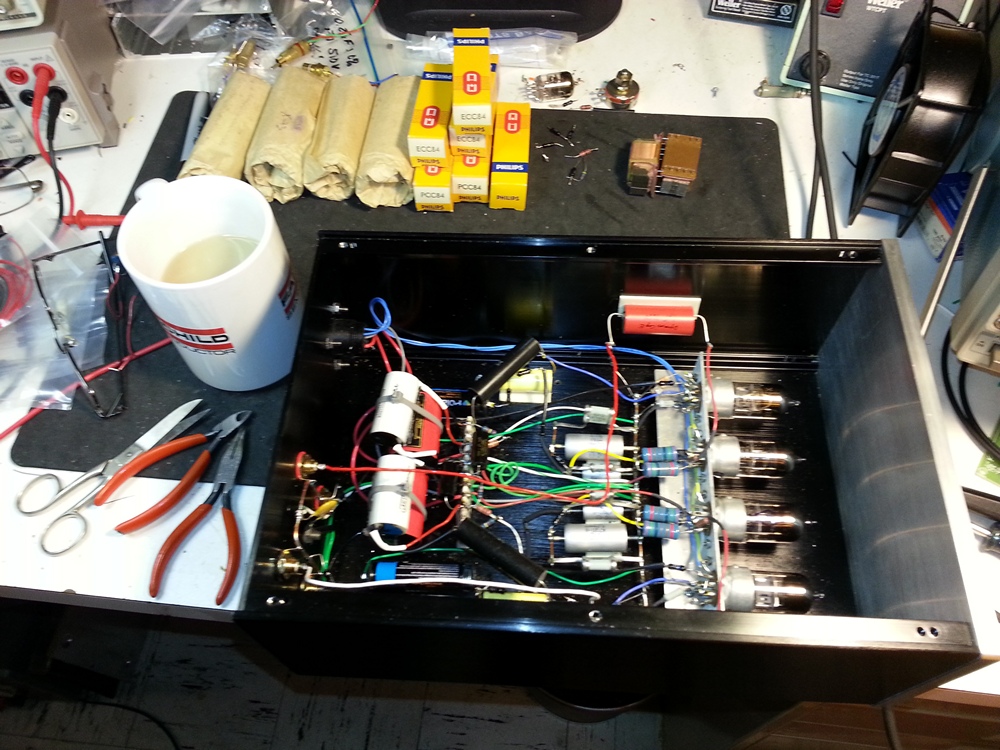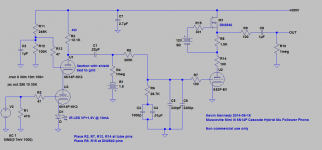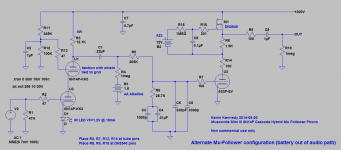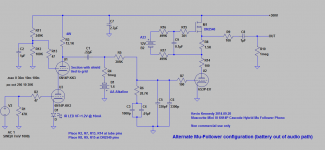Hybrid Mu-Follower Output Stage
I decided after living with this phono pre for something close to four months without significant changes that if anything I wanted to further close the gap in performance I perceived between this design and the Muscovite.
One thing that has always bothered me is the resistively loaded common cathode output stage which does not have particularly low output impedance, close to 4K in fact.. Not much margin for driving cable capacitance.
No room or budget for an additional tube per channel given the intended audience, however the Supertex DN2540 is not expensive (1.56 each two days ago) and while its gate capacitance is high, it is a great deal less than the cable capacitance this pre-amp has to drive.
Since I have penchant for weird circuit design I came up with a battery biased mu-follower, which upon first inspection looks more or less like an SRPP. (It's not and the key is the battery and source resistor..) Operating current is about 9mA - 10mA dependent on the individual fets used. (Not critical)
Output impedance drops from almost 4K to less than 150 ohms so design goal is met. Gain increases by approximately 2dB which is welcome.
Somewhat drier presentation, slight increase in low level detail. I have not done any distortion measurements, but I would not expect very significant changes.
Note mosfets are very prone to oscillation, note the gate stopper, source resistors, and locations, note added resistor on plate of 6SP3.
Edit: Added bias battery is an A23 12V alkaline.
I decided after living with this phono pre for something close to four months without significant changes that if anything I wanted to further close the gap in performance I perceived between this design and the Muscovite.
One thing that has always bothered me is the resistively loaded common cathode output stage which does not have particularly low output impedance, close to 4K in fact.. Not much margin for driving cable capacitance.
No room or budget for an additional tube per channel given the intended audience, however the Supertex DN2540 is not expensive (1.56 each two days ago) and while its gate capacitance is high, it is a great deal less than the cable capacitance this pre-amp has to drive.
Since I have penchant for weird circuit design I came up with a battery biased mu-follower, which upon first inspection looks more or less like an SRPP. (It's not and the key is the battery and source resistor..) Operating current is about 9mA - 10mA dependent on the individual fets used. (Not critical)
Output impedance drops from almost 4K to less than 150 ohms so design goal is met. Gain increases by approximately 2dB which is welcome.
Somewhat drier presentation, slight increase in low level detail. I have not done any distortion measurements, but I would not expect very significant changes.
Note mosfets are very prone to oscillation, note the gate stopper, source resistors, and locations, note added resistor on plate of 6SP3.
Edit: Added bias battery is an A23 12V alkaline.
Attachments
Hi,
Shock, horror....A SS CCS has found its way in?
Not much needed provided you keep the phono close to the line-pre, no?
@Carlp: I've thinking the same thing. A dual triode a la 6DJ8 in SRPP mode for instance?
Cheers,
Shock, horror....A SS CCS has found its way in?
One thing that has always bothered me is the resistively loaded common cathode output stage which does not have particularly low output impedance, close to 4K in fact.. Not much margin for driving cable capacitance.
Not much needed provided you keep the phono close to the line-pre, no?
@Carlp: I've thinking the same thing. A dual triode a la 6DJ8 in SRPP mode for instance?
Cheers,
Yeah, a hybrid mu-follower is a bit of a departure for me. I'm not entirely comfortable with it, the performance is promising, but as always there may be issues I will identify in the coming days. I think the turntable itself (my second TD-124) and clone SME arm may be having a bit of an issue. Not yet sure what is going on, but I was hearing a bit more sibilance than I am used to out of that set up, of course my point of reference changed. The A95 on the other table is pretty much unfazed by anything compared to the Meister Silver or Royal N so that could be it.
I've used SRPP in the past, but now tend to avoid them as they are not the most linear choice.
The additional gain that a 6S3P provides in the second position is much needed otherwise I could have considered a 6DJ8/ECC88 or similar - that tube might make more sense in the first position and would provide a significant boost in gain.
Unfortunately due to the nature of my room, the Mini must drive a minimum of 3m of interconnect cable, and currently is driving about 3.5 meters of cable - there is no solution to this. Worse many years ago I designed a budget phono stage which performed very well until I started to show it around and the testers ignored my admonitions to use low capacitance and short interconnects - the consequence was disaster. Now I try to design stuff that will drive a lot of capacitance, but the simplistic common cathode stage in this design was not cutting it on this parameter, unlike the low rp of the somewhat similar 5842 the 6S3P is around 5K.
I've used SRPP in the past, but now tend to avoid them as they are not the most linear choice.
The additional gain that a 6S3P provides in the second position is much needed otherwise I could have considered a 6DJ8/ECC88 or similar - that tube might make more sense in the first position and would provide a significant boost in gain.
Unfortunately due to the nature of my room, the Mini must drive a minimum of 3m of interconnect cable, and currently is driving about 3.5 meters of cable - there is no solution to this. Worse many years ago I designed a budget phono stage which performed very well until I started to show it around and the testers ignored my admonitions to use low capacitance and short interconnects - the consequence was disaster. Now I try to design stuff that will drive a lot of capacitance, but the simplistic common cathode stage in this design was not cutting it on this parameter, unlike the low rp of the somewhat similar 5842 the 6S3P is around 5K.
The motor in this particular TD-124 has a problem, it's fairly clear now.. The screws in the tone arm knife edge bearing were loose?? (Fixed, did I fail to tighten them sufficiently when I built this arm?) There is definitely more detail, but there is a slightly hard nasal solid state quality to the sound now which I find irritating. I will have to take a look at distortion spectra, but I suspect that I will see nothing as was the case with the 6J9P based front end.
There is definitely more low level details getting through despite my initial guarded impressions, while I hate to say it vocals seem somewhat cleaner and more intelligible, perhaps an unintended boost in the presence region masked previously by interactions with the cable capacitance?
I need to get motivated to do some measurements.
There is definitely more low level details getting through despite my initial guarded impressions, while I hate to say it vocals seem somewhat cleaner and more intelligible, perhaps an unintended boost in the presence region masked previously by interactions with the cable capacitance?
I need to get motivated to do some measurements.
Realigned the motor bearings and everything seems OK now, will wait to see what happens as it heats up again. The motor is much quieter and the noise which was audible on silent grooves (!) is now gone. This might have been a part of what I was hearing. This table is a work in progress and was just a pile of mismatched parts when I got it. Lots of eBay parts acquisitions later and some on going issues and I have a second table that sort of works most of the time, except when it doesn't.
Hi,
We all know the feeling.
Mon dieu, quelle logique implacable.
Possibly but that still doesn't explain the nasal tonality, right?
Bon courage Hercule,
I need to get motivated to do some measurements.
We all know the feeling.
I have a second table that sort of works most of the time, except when it doesn't.
Mon dieu, quelle logique implacable.
perhaps an unintended boost in the presence region masked previously by interactions with the cable capacitance?
Possibly but that still doesn't explain the nasal tonality, right?
Bon courage Hercule,
Hi Frank,
Funnily enough the nasal quality diminished when I fixed the motor issue. This table/arm/phono stage combination has always been my bete noire, things are getting sorted out a little at a time - I'll listen a bit more before making any further changes. The table is staying quiet.. I did some stuff when the neuropathy in my hands was still pretty bad and I suspect I did not tighten a few screws enough and things loosened up over time.
Still something offputting about the overall presentation despite the very audible improvement in detail. Clearly the output stage design was and is a problem.. <sigh> There may be some other things external to the pre-amp, I will swap it into the Muscovite set up which is sounding really good. (Maybe that is part of the problem? )
)
Funnily enough the nasal quality diminished when I fixed the motor issue. This table/arm/phono stage combination has always been my bete noire, things are getting sorted out a little at a time - I'll listen a bit more before making any further changes. The table is staying quiet.. I did some stuff when the neuropathy in my hands was still pretty bad and I suspect I did not tighten a few screws enough and things loosened up over time.
Still something offputting about the overall presentation despite the very audible improvement in detail. Clearly the output stage design was and is a problem.. <sigh> There may be some other things external to the pre-amp, I will swap it into the Muscovite set up which is sounding really good. (Maybe that is part of the problem?
Hi Kevin,
To avoid grub screws from rattling loose I often use Loctite 242 (the blue stuff).
I think the problem here is that you designed a dedicated phono only preamp that needs and gain and drive capability from the final stage, from a single triode no less.
You think so?
Cheers,
To avoid grub screws from rattling loose I often use Loctite 242 (the blue stuff).
I think the problem here is that you designed a dedicated phono only preamp that needs and gain and drive capability from the final stage, from a single triode no less.
(Maybe that is part of the problem? )
You think so?
Cheers,
Strangely enough with no further changes after last night it sounds just fine tonight, in fact substantially better than in its last iteration.
The table is acting like it is sorted out as well.. About as quiet as a clunker 124 can be..
Yesterday I spent about 3 hours in the car, and none today. I suspect there is a message in that somewhere..
Must be karmically speaking a better evening than last night.. lol
The table is acting like it is sorted out as well.. About as quiet as a clunker 124 can be..
Yesterday I spent about 3 hours in the car, and none today. I suspect there is a message in that somewhere..

Must be karmically speaking a better evening than last night.. lol
Hi Frank,
One interesting thought is the transconductance of the DN2540 is very dependent on the drain current which in this case is 9 -10mA, looking at the curves I expect the transconductance is only in the realm of 50000umhos, rather than the 200 - 300K available at higher currents, what this means is that the source impedance at the source (lol) is about 20 ohms - really rather good even with the 100 ohms on the output for stability into cable capacitance. I could boost the current by about 5mA into the follower section only, but this does not seem like a big win and will tax the PSU to the limit.
It is sounding much better, and after two hours it is still not annoying me so either I am sourd or c'est pas mal.
On the arm screw issue I am not sure whether I just failed to tighten them sufficiently when I built the clone 3012 or they loosened up due to thermal cycling and vibration from the vigorous SPUs.. I will check them from time to time. The clue was that the stub was floppy when I went to adjust the static balance upon changing to a different SPU..
The motor issue definitely has to do with the lack of strength and feeling in my hands at the time I last pulled that motor apart, I clearly also mis-aligned the motor bearings which I think you will agree under the circumstances was understandable. It's definitely sorted out, and is sounding fine.
One interesting thought is the transconductance of the DN2540 is very dependent on the drain current which in this case is 9 -10mA, looking at the curves I expect the transconductance is only in the realm of 50000umhos, rather than the 200 - 300K available at higher currents, what this means is that the source impedance at the source (lol) is about 20 ohms - really rather good even with the 100 ohms on the output for stability into cable capacitance. I could boost the current by about 5mA into the follower section only, but this does not seem like a big win and will tax the PSU to the limit.
It is sounding much better, and after two hours it is still not annoying me so either I am sourd or c'est pas mal.
On the arm screw issue I am not sure whether I just failed to tighten them sufficiently when I built the clone 3012 or they loosened up due to thermal cycling and vibration from the vigorous SPUs.. I will check them from time to time. The clue was that the stub was floppy when I went to adjust the static balance upon changing to a different SPU..
The motor issue definitely has to do with the lack of strength and feeling in my hands at the time I last pulled that motor apart, I clearly also mis-aligned the motor bearings which I think you will agree under the circumstances was understandable. It's definitely sorted out, and is sounding fine.
The motor issue definitely has to do with the lack of strength and feeling in my hands at the time I last pulled that motor apart, I clearly also mis-aligned the motor bearings which I think you will agree under the circumstances was understandable.
Indeed. Glad that part is over and you're back to working on these things. Last night I was sniffing solder fumes. Don't get too excited. It takes me ages to do a build like this. But I've started on the 6J9P version and will build it, then tear it apart to try this 6N14P version. All in the name of learning.
Carl
Hi Carl,
Fortunately the changes to convert from the 6J9P version to this one are pretty easily implemented. Once I figured out the design the changes were made in an hour or so..
The DN2540 is definitely a worthwhile addition, it is a pretty big improvement in a number of areas. It isolates the 6S3P plate circuit from the effects of external capacitance, and also provides a couple of dB of additional gain, both which are worthwhile improvements. This change results in a livelier, and more detailed sounding presentation. (It is also less tubey sounding for those who might be concerned about such things.)
Fortunately the changes to convert from the 6J9P version to this one are pretty easily implemented. Once I figured out the design the changes were made in an hour or so..
The DN2540 is definitely a worthwhile addition, it is a pretty big improvement in a number of areas. It isolates the 6S3P plate circuit from the effects of external capacitance, and also provides a couple of dB of additional gain, both which are worthwhile improvements. This change results in a livelier, and more detailed sounding presentation. (It is also less tubey sounding for those who might be concerned about such things.)
Revision to remove mu-follower battery from circuit path.
Provided for those who might object to signal current following through the bias battery. I am not sure at this point whether or not this is a worthwhile change - have yet to evaluate it, but it strikes me that a good quality film cap may be better than a battery in terms of interacting with the signal.
Version 2 isolates the battery and its capacitive coupling to surrounding chassis, etc., from the audio path while providing the required DC bias for the follower.
Provided for those who might object to signal current following through the bias battery. I am not sure at this point whether or not this is a worthwhile change - have yet to evaluate it, but it strikes me that a good quality film cap may be better than a battery in terms of interacting with the signal.
Version 2 isolates the battery and its capacitive coupling to surrounding chassis, etc., from the audio path while providing the required DC bias for the follower.
Attachments
Hi,
Indeed. Which is what made me think about how it would sound if the signal were to be taken at the lower output node. Just curious how that would affect the sound.
As for it less tubey sounding, that should be easy to reveal in the distortion analysis. Overall there should less distortion but also much less even order distortion compared to a resistively loaded stage. (I know you know all that)
The only way to keep the tubey sound is to up the B+ and plate resistor.
Traditionally most people seem to be scared (or rather uncomfy) around voltages over the 300 mark.
Some valves (the 12AX7/ECC83 comes to mind) only starts to shine at a B+ of over 400VDC and a > 300K anode R.
Personally I like the sound of a classic resistively loaded stage without its typical cathode bias R and its bypass cap. (I think you do as well IIRC)
A fiver says the cap wins.
Cheers,
The DN2540 is definitely a worthwhile addition, it is a pretty big improvement in a number of areas. It isolates the 6S3P plate circuit from the effects of external capacitance, and also provides a couple of dB of additional gain, both which are worthwhile improvements. This change results in a livelier, and more detailed sounding presentation. (It is also less tubey sounding for those who might be concerned about such things.)
Indeed. Which is what made me think about how it would sound if the signal were to be taken at the lower output node. Just curious how that would affect the sound.
As for it less tubey sounding, that should be easy to reveal in the distortion analysis. Overall there should less distortion but also much less even order distortion compared to a resistively loaded stage. (I know you know all that)
The only way to keep the tubey sound is to up the B+ and plate resistor.
Traditionally most people seem to be scared (or rather uncomfy) around voltages over the 300 mark.
Some valves (the 12AX7/ECC83 comes to mind) only starts to shine at a B+ of over 400VDC and a > 300K anode R.
Personally I like the sound of a classic resistively loaded stage without its typical cathode bias R and its bypass cap. (I think you do as well IIRC)
- have yet to evaluate it, but it strikes me that a good quality film cap may be better than a battery in terms of interacting with the signal.
A fiver says the cap wins.

Cheers,
Strangely enough with no further changes after last night it sounds just fine tonight, in fact substantially better than in its last iteration.
Pictures, please.

Hi,
See posts # 17, 28 etc.
Which incidentally made me relook at some pics just to spot this:

Note how Kevin turned the mug so it's hard to spot it was offered to him by Fairchild.
And that whilst soldering a tube circuit....No wonder then he finally succumbed to using a solid state CCS......
Cheers,
See posts # 17, 28 etc.
Which incidentally made me relook at some pics just to spot this:
Drinking tea is frankly questionable, but I'm not putting my lead covered fingers in the cup or my mouth so..

Note how Kevin turned the mug so it's hard to spot it was offered to him by Fairchild.
And that whilst soldering a tube circuit....No wonder then he finally succumbed to using a solid state CCS......

Cheers,
Last edited:
- Status
- This old topic is closed. If you want to reopen this topic, contact a moderator using the "Report Post" button.
- Home
- Source & Line
- Analogue Source
- The Muscovite Mini II 6N14P Phono Stage


